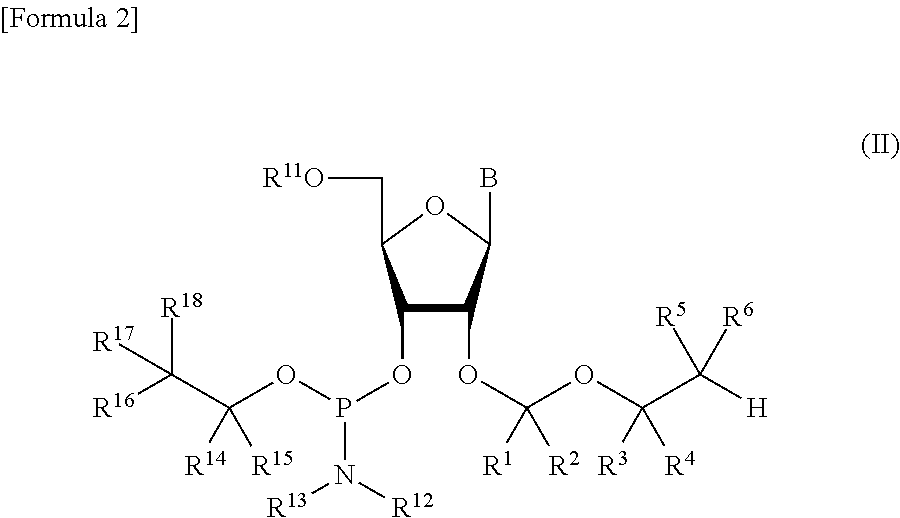Novel protective group for synthesis of RNA and derivative
a protective group and derivative technology, applied in the direction of group 5/15 element organic compounds, sugar derivates, chemical production, etc., can solve the problems of significant influence on the production yield, reduced the efficiency of condensation reaction for generating nucleotides, and solid phase synthetics, etc., to achieve efficient removal in a short time, easy removal, and little steric hindrance
- Summary
- Abstract
- Description
- Claims
- Application Information
AI Technical Summary
Benefits of technology
Problems solved by technology
Method used
Image
Examples
example 1
(a) 2′-O-(2-Trifluoromethyl-3,3,3-trifluoropropanoxymethyl)-3′,5′-O-(1,1,3,3-tetraisopropyldisiloxane-1,3-diyl)uridine (1u)
[0054]
[0055]2′-O-Methylthiomethyl-3′,5′-O-(1,1,3,3-tetraisopropyldisiloxane-1,3-diyl)uridine (136.7 mg, 250 μmol, Journal of Fluorine Chemistry, 24, pp. 531-533, 1984) was dried by repeated coevaporation with dry toluene, and finally dissolved in tetrahydrofuran (1.5 mL). To the solution, 2-trifluoromethyl-3,3,3-trifluoropropanol (250 μL, 750 μmol) and molecular sieves 4A were added, and the reaction mixture was cooled to −78° C. NIS (67.5 mg, 300 μmmol) and TMSOTf (45 μL, 250 μmmol) were added to the reaction mixture. After stirring over 10 minutes, the mixture was warmed to 0° C., and stirring was continued for 1 hour. Then the reaction was quenched with Et3N (75 μl). The reaction mixture was diluted with chloroform (25 mL), and washed successively with saturated aqueous Na2S2O3 (25 mL) and saturated aqueous NaHCO3 (25 mL). The organic layer was dried over Na2...
example 2
(a) N6-Acetyl-2′-O-(2-trifluoromethyl-3,3,3-trifluoropropanoxymethyl)-3′,5′-O-(1,1,3,3-tetraisopropyldisiloxane-1,3-diyl)adenosine (1a)
[0070]
[0071]This compound was synthesized in the same manner as that used for the compound 1u by using N6-acetyl-2′-O-methylthiomethyl-3′,5′-O-(1,1,3,3-tetraisopropyldisiloxane-1,3-diyl)adenosine instead of 2′-O-methylthiomethyl-3′,5′-O-(1,1,3,3-tetraisopropyldisiloxane-1,3-diyl)uridine. Yield was 65% (white foam).
[0072]1H NMR (300 MHz, CDCl3) δ 8.63 (1H, s), 8.55 (1H, brs), 8.32 (1H, s), 6.08 (1H, s), 5.10 (1H, d, J=7.2 Hz), 4.96 (1H, d, J=7.2 Hz), 4.67 (1H, dd, J=9.6, 4.5 Hz), 4.48 (1H, d, J=4.5 Hz), 4.34-4.14 (3H, m) 4.08-3.96 (2H, m), 3.53-3.38 (1H, m), 2.62 (3H, s), 1.16-0.92 (28H, m)
[0073]13C NMR (75.5 MHz, CDCl3) δ 170.4, 152.3, 150.1, 149.2, 140.75, 123.0 (2C, q, J=281.8 Hz), 122.3, 95.0, 88.7, 81.5, 78.1, 69.0, 61.4, 59.5, 49.0 (1C, quintet, J=27.9 Hz), 25.7, 17.4, 17.3, 17.2, 17.0, 16.9, 16.9, 16.8, 13.3, 12.9, 12.8, 12.6
[0074]MALDI TOF-MS ...
example 3
(a) N4-Acetyl-2′-O-(2-trifluoromethyl-3,3,3-trifluoropropanoxymethyl)-3′,5′-O-(1,1,3,3-tetraisopropyldisiloxane-1,3-diyl)cytidine (1c)
[0086]
[0087]This compound was synthesized in the same manner as that used for the compound 1u by using N4-acetyl-2′-O-methylthiomethyl-3′,5′-O-(1,1,3,3-tetraisopropyldisiloxane-1,3-diyl)cytidine instead of 2′-O-methylthiomethyl-3′,5′-O-(1,1,3,3-tetraisopropyldisiloxane-1,3-diyl)uridine. Yield was 62% (white foam).
[0088]1H NMR (300 MHz, CDCl3) δ 9.20 (1H, brs), 8.31 (1H, d, J=7.5 Hz), 7.41 (1H, d, J=7.5 Hz), 5.77 (1H, s), 5.12 (1H, d, J=6.9 Hz), 4.98 (1H, d, J=6.9 Hz), 4.32-3.94 (7H, m), 3.50-3.34 (1H, m), 2.24 (3H, s), 1.11-0.88 (28H, m)
[0089]13C NMR (75.5 MHz, CDCl3) δ 171.2, 163.4, 154.8, 144.0, 123.1 (2C, q, J=281.5 Hz), 96.6, 94.7, 89.9, 81.9, 78.3, 67.6, 61.3, 59.3, 48.8 (1C, quintet, J=27.6 Hz), 24.7, 17.5, 17.4, 17.3, 17.2, 16.9, 16.9, 16.8, 13.2, 13.1, 12.8, 12.5
[0090]MALDI TOF-MS m / z Calcd for C28H45F6N3NaO8Si2+ [M+Na]+ 744.25; found 744.97.
(...
PUM
| Property | Measurement | Unit |
|---|---|---|
| temperature | aaaaa | aaaaa |
| temperature | aaaaa | aaaaa |
| time | aaaaa | aaaaa |
Abstract
Description
Claims
Application Information
 Login to View More
Login to View More - R&D
- Intellectual Property
- Life Sciences
- Materials
- Tech Scout
- Unparalleled Data Quality
- Higher Quality Content
- 60% Fewer Hallucinations
Browse by: Latest US Patents, China's latest patents, Technical Efficacy Thesaurus, Application Domain, Technology Topic, Popular Technical Reports.
© 2025 PatSnap. All rights reserved.Legal|Privacy policy|Modern Slavery Act Transparency Statement|Sitemap|About US| Contact US: help@patsnap.com



